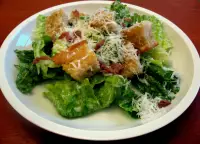Last night, our friends Bruno and Jill came for dinner and we followed a sort of loose “sea & salt” theme throughout. We kicked off (as we always do) with an apéritif. “Apéritif” is a French word derived from the Latin verb aperire, which means “to open.” So an apéritif is an alcoholic beverage usually served before a meal to stimulate the appetite, and is therefore usually dry rather than sweet. Common choices for an apéritif are vermouth, champagne, pastis, gin, rak?, fino, amontillado or other styles of dry sherry and any still, dry, light white wine. The word also refers to a snack that precedes a meal. This includes an amuse-bouche, such as crackers, cheese, pâté or olives.
Our own apéritifs will always include a light, dry wine (or champagne) which we often flavour with ‘Crême de Something’ (depending on the person’s choice). We discovered a long time ago that ‘Crême de ….” costs a bomb in UK! We searched hard and all we found was a Black Raspberry Liqueur made by Chambord. A bottle of just 20cl (about one-third of a pint) cost us over £10 (€12 – $16). So now, when we come from France by car, we load up with 50cl (¾ pint) bottles which we buy for about €3 each (£2.50 – $4).
We have a great selection now of Crême de Pamplemousse Rose (pink grapefruit), Crême de Pêche de Vigne (Vine Peaches), Crême de Framboise (Raspberry), Crême de Mûres (Blackberries) and Crême de Fruits Rouges (Red Fruits). Curiously, what I don’t have is the all-time classic, Crême de Cassis (Blackcurrant) which was the original drink.
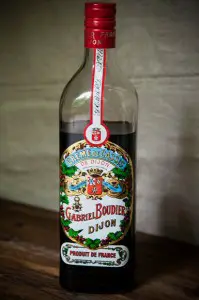 White wine with Crême de Cassis is known as “Kir” in France and is a popular apéritif drink named after Félix Kir (1876–1968), mayor of Dijon in Burgundy, who popularized the drink by offering it at receptions to visiting delegations. Besides treating his international guests well, he was also promoting two vital economic products of the region – blackcurrants and white wine.
White wine with Crême de Cassis is known as “Kir” in France and is a popular apéritif drink named after Félix Kir (1876–1968), mayor of Dijon in Burgundy, who popularized the drink by offering it at receptions to visiting delegations. Besides treating his international guests well, he was also promoting two vital economic products of the region – blackcurrants and white wine.
So, due to our collection of different flavour liqueurs, we can offer guests a choice and, in fact, outside France it can be a great talking point as guests sample first one and then another! Last night, we served our Kirs using a lovely crisp Chardonnay that we happen to have sitting in the fridge. And as an amuse-bouche, we also served large green-lipped mussels from New Zealand. We buy these already cooked from the local supermarket and I then finely chop garlic, sprinkle it over the mussels in their shells and drizzle a generous amount of Salad dressing over them. They are really delicious and our guests certainly seemed to appreciate them.
For a starter course, we once again resorted to Julie’s Salmon & Prawn with Lime which has become a real favourite. Jill cleverly guessed all the ingredients in the salad dressing and also spotted the horseradish and crême fraîche mixture for what it was. The salmon was wild Pacific Keta Salmon (sometimes known as chum or dog salmon for its dog-like teeth). It has a lower fat content than other salmon but is a really rich, tasty and healthy fish. With the fish starter, we served the same Duc de Morny 2012 Picpoul de Pinet that we served last week when we had “the Steves” with us.
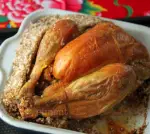 The main course was the “salty” end of the recipe with Chicken in a salt crust otherwise known as Poulet a l’ail et aux Fines Herbes en croute de Sel Parfumée. This is a great way to serve chicken since it always comes out tender and succulent and the taste is just out of this world.
The main course was the “salty” end of the recipe with Chicken in a salt crust otherwise known as Poulet a l’ail et aux Fines Herbes en croute de Sel Parfumée. This is a great way to serve chicken since it always comes out tender and succulent and the taste is just out of this world.
In fact, you start with a chicken (nice corn-fed, free range one for us) and you insert Boursin Soft Cheese with Garlic and Herbs (Boursin Ail et Fines Herbes) between the skin and the flesh. During the cooking process, this “melts” into and around the flesh leaving a taste that has to be tried to be believed.
 Once the chicken has been treated with the Boursin, you build a complete casing for it using coarse salt, flour, rosemary, thyme, baies, peppercorns and egg whites. It ends up looking like a bomb, but part of the fun of this recipe (and, yes, food should be fun too!) is, prior to serving, showing your guests the cooked “bomb” and seeing if any of them can guess what’s inside. Then, of course, you take it back to the kitchen and remove the salt crust (which takes a certain amount of brute force and muscle!)
Once the chicken has been treated with the Boursin, you build a complete casing for it using coarse salt, flour, rosemary, thyme, baies, peppercorns and egg whites. It ends up looking like a bomb, but part of the fun of this recipe (and, yes, food should be fun too!) is, prior to serving, showing your guests the cooked “bomb” and seeing if any of them can guess what’s inside. Then, of course, you take it back to the kitchen and remove the salt crust (which takes a certain amount of brute force and muscle!)
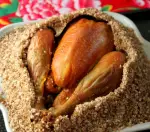 Once you have opened up the crust, you will find (every time without fail) a perfectly cooked golden brown bird, ready to be segmented and served in portions or, very simply, placed on a serving dish and carved at the table. We served ours with mini Brussels sprouts and new potatoes. No need for any sort of sauce or gravy, the moist chicken meat was more than enough – particularly when helped down with a couple of bottles of Domaine du Landetran, L’Ame des Schistes 2010 (well, come on, be fair, there were four of us!).
Once you have opened up the crust, you will find (every time without fail) a perfectly cooked golden brown bird, ready to be segmented and served in portions or, very simply, placed on a serving dish and carved at the table. We served ours with mini Brussels sprouts and new potatoes. No need for any sort of sauce or gravy, the moist chicken meat was more than enough – particularly when helped down with a couple of bottles of Domaine du Landetran, L’Ame des Schistes 2010 (well, come on, be fair, there were four of us!).
After the cheese, we had planned serving M-D’s “Parfait” but Bruno had made a chocolate cake so we got stuck into that instead… and very good it was too. (Particularly washed down with a glass or Maas a Miel).
And so passed a very pleasant evening in good company. Bruno and Jill found their way home at about 1:30am and I eventually got to bed at 2:45am after clearing the mess I had made in the kitchen (better that than face it the next morning!)
Entertaining is fun, particularly with people you like… and we really DO like all our guests. They are all different. They all have different tastes. The conversations are always different. But the one common factor is a convivial evening spent around the table with good food and decent wine. It makes life worth living!
 We spent an informal Christmas Day this year in the company of two good friends, Florence and her son, Damien. We also decided to keep it simple, so we kicked off with smoked wild salmon from Olsen Bornholm, a specialist smoke house and curers, just a mile from where we live. But we dressed it up a bit and turned it into Julie’s Salmon and Prawn with Lime. This is such an easy recipe and it’s been a huge success every time we’ve done it. Damien was more impressed with Marie-Danielle’s hat. And a mighty fine hat it was too!
We spent an informal Christmas Day this year in the company of two good friends, Florence and her son, Damien. We also decided to keep it simple, so we kicked off with smoked wild salmon from Olsen Bornholm, a specialist smoke house and curers, just a mile from where we live. But we dressed it up a bit and turned it into Julie’s Salmon and Prawn with Lime. This is such an easy recipe and it’s been a huge success every time we’ve done it. Damien was more impressed with Marie-Danielle’s hat. And a mighty fine hat it was too!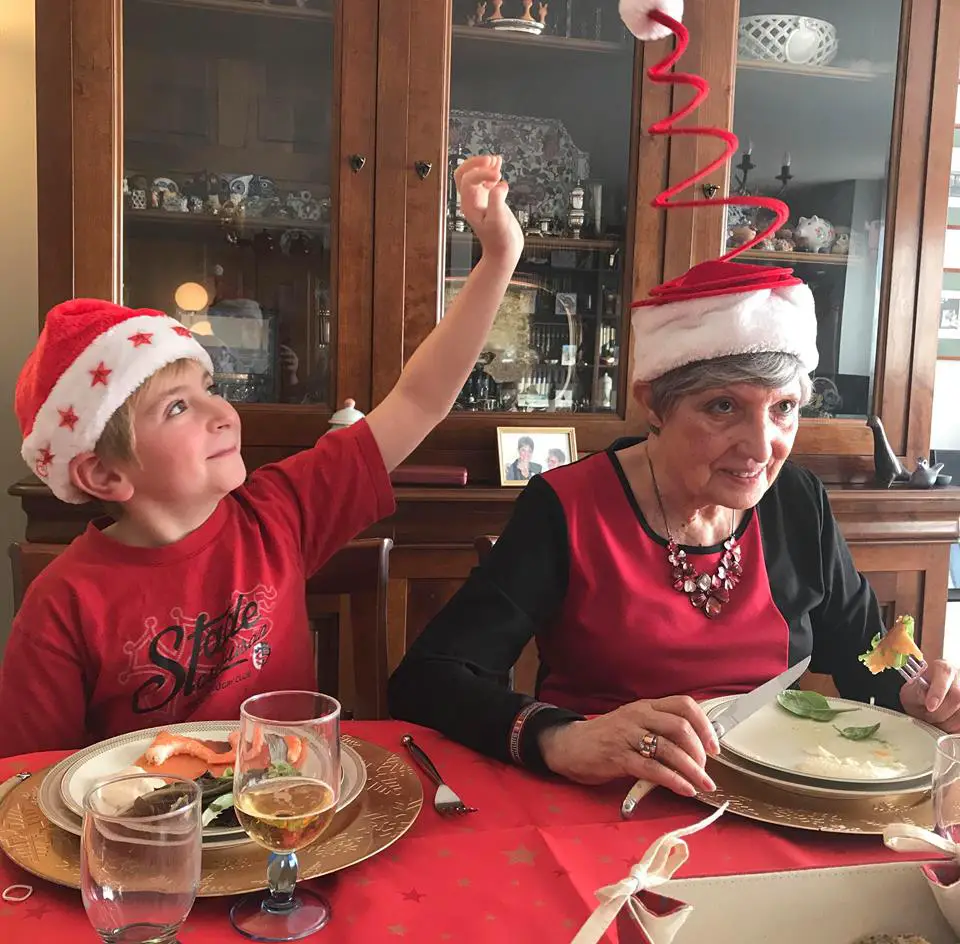
 Florence lives in the heart of Paris and she had brought with her some truly wonderful cheeses that we took our time over. She also brought the deserts – delicious hand-made cakes from one of the best patisseries in the capital. We would have been happy if she had just brought herself and Damien, but the cheese and desserts were an added bonus.
Florence lives in the heart of Paris and she had brought with her some truly wonderful cheeses that we took our time over. She also brought the deserts – delicious hand-made cakes from one of the best patisseries in the capital. We would have been happy if she had just brought herself and Damien, but the cheese and desserts were an added bonus.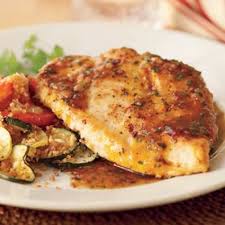 Many people avoid chicken breasts because they find them dry, tasteless and boring. Others choose the breast (preferably without the skin) and avoid the darker meat of the leg and thigh. Personally, I’m in the breast meat camp while my wife is in the dark meat camp. I’m perfectly happy with properly cooked, flavourful white meat on my plate. But when eating out, that becomes a problem because properly cooked chicken breast is hard to find.
Many people avoid chicken breasts because they find them dry, tasteless and boring. Others choose the breast (preferably without the skin) and avoid the darker meat of the leg and thigh. Personally, I’m in the breast meat camp while my wife is in the dark meat camp. I’m perfectly happy with properly cooked, flavourful white meat on my plate. But when eating out, that becomes a problem because properly cooked chicken breast is hard to find.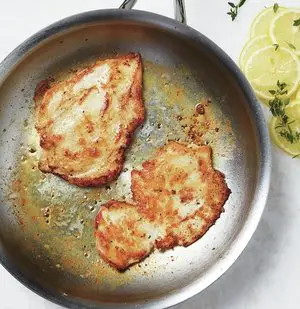 So, working with one piece at a time, place the chicken between two pieces of plastic wrap and pound with a mallet, a rolling pin, or the bottom of a skillet to an even ½-inch thickness. The paillards will now only take a few minutes in a skillet or frying pan to cook.
So, working with one piece at a time, place the chicken between two pieces of plastic wrap and pound with a mallet, a rolling pin, or the bottom of a skillet to an even ½-inch thickness. The paillards will now only take a few minutes in a skillet or frying pan to cook.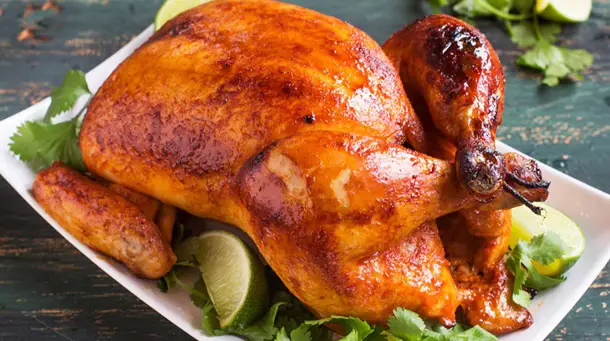 Sometimes you know you have a busy afternoon planned so you want dinner to cook itself. And so it can with
Sometimes you know you have a busy afternoon planned so you want dinner to cook itself. And so it can with  To cut a long story short, we had a long “apperitif” with Jean-Louis and France while we waited for Christine, and then sat down to eat just before 3pm! Fortunately, the
To cut a long story short, we had a long “apperitif” with Jean-Louis and France while we waited for Christine, and then sat down to eat just before 3pm! Fortunately, the 

 White wine with Crême de Cassis is known as “Kir” in France and is a popular apéritif drink named after Félix Kir (1876–1968), mayor of Dijon in Burgundy, who popularized the drink by offering it at receptions to visiting delegations. Besides treating his international guests well, he was also promoting two vital economic products of the region – blackcurrants and white wine.
White wine with Crême de Cassis is known as “Kir” in France and is a popular apéritif drink named after Félix Kir (1876–1968), mayor of Dijon in Burgundy, who popularized the drink by offering it at receptions to visiting delegations. Besides treating his international guests well, he was also promoting two vital economic products of the region – blackcurrants and white wine. The main course was the “salty” end of the recipe with
The main course was the “salty” end of the recipe with 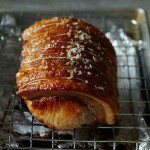 Before leaving the island, Terry and Julie invited us to theirs for a splendid roast dinner. Never has so much good grub been served to so few without collapsing the table! It was delicious and, for me, brought back great memories of pork crackling and roast spuds and parsnips and oh so much more. I suspect we also did some considerable damage to Terry’s stock of wine. There seemed to be a lot of empty bottles rattling round at the end! (Reminder to myself: I need to get Julie’s recipe for the starter… a lovely little salad with a vinaigrette that was as light as fairy wings and as tasty as … well, anything you can possibly imagine!)
Before leaving the island, Terry and Julie invited us to theirs for a splendid roast dinner. Never has so much good grub been served to so few without collapsing the table! It was delicious and, for me, brought back great memories of pork crackling and roast spuds and parsnips and oh so much more. I suspect we also did some considerable damage to Terry’s stock of wine. There seemed to be a lot of empty bottles rattling round at the end! (Reminder to myself: I need to get Julie’s recipe for the starter… a lovely little salad with a vinaigrette that was as light as fairy wings and as tasty as … well, anything you can possibly imagine!)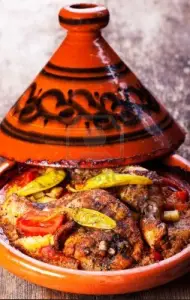 Also, before leaving the island, Bruno and Jill invited us to theirs for a dinner. Bruno had prepared a great tajine for us. A tagine is a dish from North Africa that is named after the special earthenware pot in which it is cooked. The traditional pot is formed entirely of a heavy clay and consists of two parts: a base unit that is flat and circular with low sides and a large cone-shaped cover that sits on the base during cooking. The cover is designed to return all condensation to the bottom. With the cover removed, the base can be taken to the table for serving.
Also, before leaving the island, Bruno and Jill invited us to theirs for a dinner. Bruno had prepared a great tajine for us. A tagine is a dish from North Africa that is named after the special earthenware pot in which it is cooked. The traditional pot is formed entirely of a heavy clay and consists of two parts: a base unit that is flat and circular with low sides and a large cone-shaped cover that sits on the base during cooking. The cover is designed to return all condensation to the bottom. With the cover removed, the base can be taken to the table for serving. Also before leaving, we had a pleasant evening with my brother Steve and my sister-in-law, Jeanette. They’re great at keeping an eye on the house while we are away, not to mention forwarding the mail, looking after my car and much more. For some reason, however, the whole summer had passed by without the four of us having a quiet evening together. So, since Steve and Jeanette had been to Scotland earlier in the year and had brought us back a haggis, I decided to do my famous
Also before leaving, we had a pleasant evening with my brother Steve and my sister-in-law, Jeanette. They’re great at keeping an eye on the house while we are away, not to mention forwarding the mail, looking after my car and much more. For some reason, however, the whole summer had passed by without the four of us having a quiet evening together. So, since Steve and Jeanette had been to Scotland earlier in the year and had brought us back a haggis, I decided to do my famous 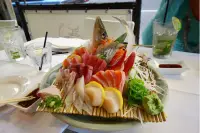 Since being back, we have, of course, been to our “local” –
Since being back, we have, of course, been to our “local” – 